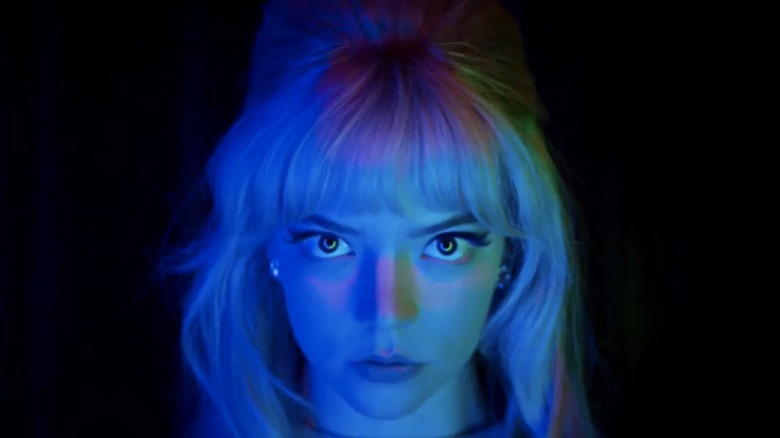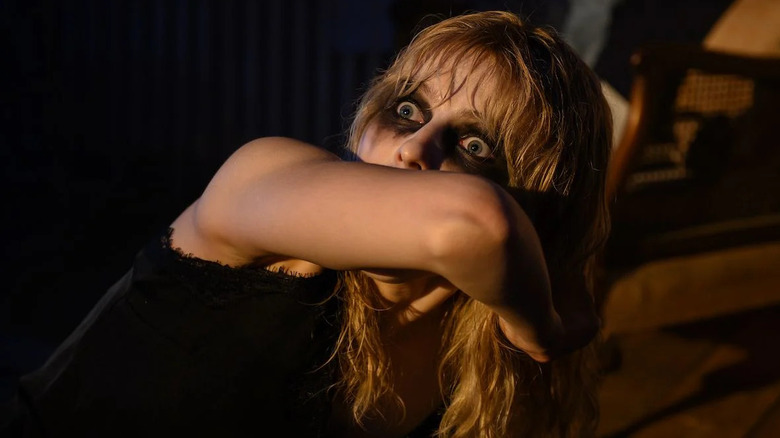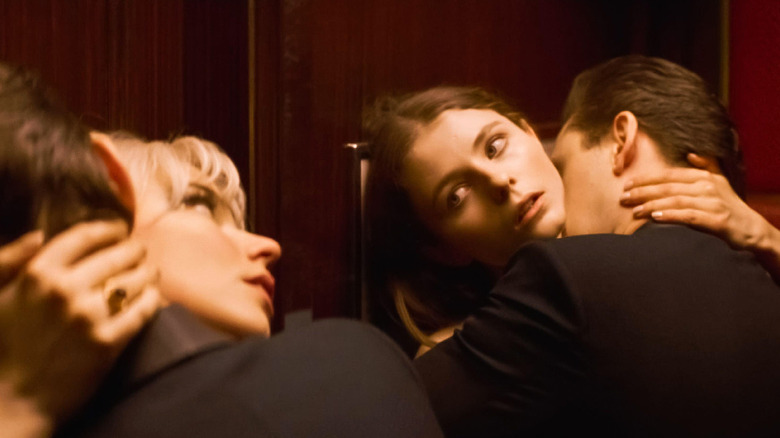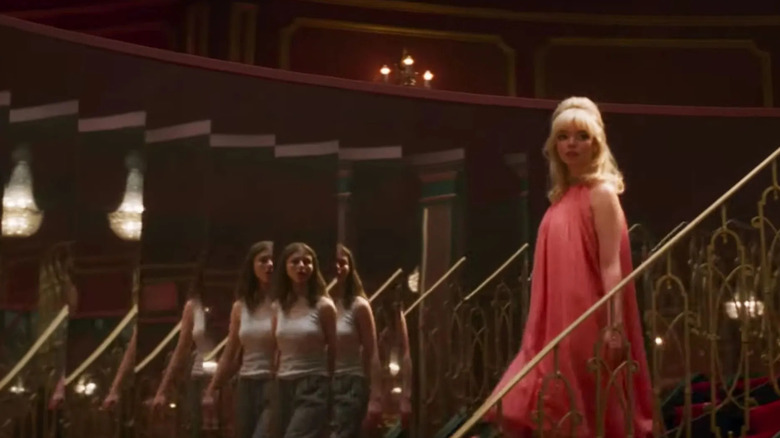Last Night In Soho Spoiler Review: A Technically Astonishing And Often Muddy Horror Tale
Warning: major spoilers ahead for "Last Night in Soho."
We live in a time that's positively drowning in nostalgia, this escapist obsession with an often idealized past that's frequently inaccurate and sometimes, indeed, dangerous. When the past becomes an obsession, it's as easy to get disconnected from our world as it is to misunderstand and romanticize days or eras gone by. Eloise, or Ellie, the "Last Night in Soho" protagonist ably played by Thomasin McKenzie, sees her life upended when she literally succumbs to both grave ills.
Eloise is haunted by the tragic death of her mother. In many ways, she's uncomfortable in her own time — she makes her own clothes, sits uncomfortably with her contemporaries at modern parties, and is hesitant to go out into the modern, fast paced world. Ellie listens to the music of the 1960s and longs to see the world of that era. She soon finds herself eschewing the assigned university abode for an upstairs bedroom trapped equally in the '60s, complete with a home phone, record player, and rules about visitors that fit well in the past. It's an experience that soon becomes addicting, and then deadly.
Edgar Wright's new film is a visually stunning ode to giallo with a banging soundtrack, stunning visuals, and whip-tight editing. It's swinging big, and that's always welcome, but its handling of thematic issues is mixed while the over-reliance on obvious CGI hampers what would be a technical marvel. It is a film whose virtues conflict with its faults, but one that is easily worth an audience's time.
"I've got this kind of gift"
One strange night, Eloise finds herself drifting off to sleep (in a stunning surreal sequence), finding herself transported into swinging 1960s London. Her vehicle (literally the body she's a passenger in for her tour of the past) is the hopeful Sandie (Anya Taylor-Joy) — a gorgeous, put-together singer/dancer/all-around performer. At first, Eloise is elated. She's infatuated. She has to come back again and again to relive the past through the eyes of this glamorous ingenue.
The film is, on the one hand, very overt about the dangers of nostalgia, or at the very least being obsessed with it. The longer Eloise stays in the past, the more it infects her, changes her, makes her disassociate from her own time and endanger herself and others in her own. She has to finish the story, and yet the line between her and Sandie blurs. This psychological effect is amplified by the literal bleeding of the past into the present via a slew of faceless dead men that haunt her waking daily life. The ghosts, we discover, are Sandie's various Johns-turned-victims as she was forced by her nefarious manager/pimp Jack (Matt Smith) into prostitution. Sandie routinely killed these men, and shoved them under the floorboards of the flat that Eloise has been staying in (and oh my, that would smell).
What's interesting about Ellie's journey through this retro hell is that it proceeds at first with a variety of potential interpretations. Is Ellie mad, perhaps too far outside her comfort zone with the stresses of school and London? Is she actually being sent through time, somehow engaged in a form of time travel through which Sandie is the vehicle? Is there something grander afoot, as the past becomes the present and dapper faceless ghouls haunt her waking life? With the twist that she hasn't snapped, this is happening and Sandie is the source of the haunting, the nostalgia theme largely lands: Ellie's attachment to and idealization of the past lands her in trouble as her increasingly frazzled mind becomes an increasingly terrified one. The threat becomes all the more poignant as she discovers that Sandie is her landlady Ms. Collins, and the latter seeks to kill both Ellie and her love interest John (Michael Ajao). Nostalgia literally kills.
"This is the closest most people get to their dreams"
On the one hand, Ellie's idealization and obsession with the past blinds her both to the dangers of the present, putting her in danger. It makes the theme of the film, the rejection of nostalgia, work. At the same time, it makes a mess of other elements of the script that one can't help but wish were handled differently.
Another lens to explore the film lies in an engagement with Sandie's own path through 1960's London, which we see through Eloise's perspective. Like Eloise, Sandie has stars in her eyes and hopes to make it big in the city (albeit with vastly more self-assuredness than the former). She meets Jack (Smith is properly menacing and charismatic here), who smooth-talks his way into her heart and her career as a manger.
First comes background dancer roles at clubs — everyone starts small, he says. Soon Sandie's path darkens, as Jack seems more intent on pivoting Sandie into prostitution than boosting her career onstage. One day, she pulls away from his control, and in a rage he comes at her blade in hand. Eloise fears Sandie's death (and from this point on, the visions of a horde of faceless male ghosts invade her life). While Sandie was a victim of many things — predatory Jack, a host of skeezy men, and a patriarchal society that made young aspirant women so vulnerable among them — it wasn't her blood in Eloise's vision... it was Jack's. She killed him, and proceeded the serial killing of various Johns that trapped a host of ghosts in her home for decades.
Here's where some of the film's thematic elements get messy.
While the plot device of Ellie being a passenger in Sandie's life provides an interesting perspective, it's a little odd in a film so evidently dedicated to criticizing rampant misogyny and the violation of women's autonomy. When Ellie's in the past, she's an impotent passenger in Sandie's life. She's a tourist in a host of sufferings in a way that bleeds into Ellie's own life when the past comes to haunt her (and in seeing Sandie at the end, that never seems to go away). Meanwhile, Sandie herself experiences a number of terrible experiences of autonomy violation. On top of that, she has a young woman from the future watching her every move and touring her body. It doesn't make or break the plot per se, but it's surely an odd choice for a film that so often highlights the importance of women's agency in other realms.
More fatally, its troubling to find out that Sandie effectively abandoned her dreams in favor of life as a serial killer and that the faceless ghosts aren't her time-locked tormenters as much as they're the ghastly remnants of Sandie's myriad victims. It's an odd emotional and conceptual pivot to show us the host of invasions of autonomy that this young hopeful woman has suffered and then make her, in effect, a villain. She's not getting retribution against the men who have wronged her (the version of "Promising Young Woman" I wanted but did not get), she ably dispatches her coercive former "manager" but then actively seeks out new men to lure, murder, and bury. She's the source of Ellie's undeserved psychological terrors, and then seeks to kill her. The long-suffering Sandie doesn't regain agency — she somehow becomes the villain in a film full of obvious other predators. It's an intellectually interesting but conceptually muddled slide that doesn't serve the film's dedicated investment in Sandie's and Ellie's sufferings.
"Do you believe in ghosts?"
On a technical level, the film truly shines. Any new Edgar Wright movie will be in the running for the tightest, most artful and precise editing that year. This film is no exception, with tight pacing and editing (with longtime Wright collaborator Paul Machliss, who deserves an Oscar already) that makes for an enjoyable watch and a brilliant visceral experience. The cinematography by longtime Park Chan-wook collaborator Chung-hoon Chung is also brilliant, capturing the feel of both eras with ease. It's a visual stunner, complete with grimy giallo influences. The soundtrack, too, is unsurprisingly fantastic. Music is often central to how Wright conceives and tells his stories, and it certainly shows here. A lovely side effect of such organic musical incorporation is a wonderful sense of pace. The film just breezes by.
While the film boasts a number of technical accomplishments across the realms of editing, cinematography, and production design, there are issues with its over-reliance on very transparent CGI that doesn't meet the visual level of its cinematography and practical effects. The visage of the ghastly faceless men is conceptually shocking. In execution, it's a needlessly transparent CGI effect (when practical would have been exceptional here), and once they show up, they're deployed with the subtlety of an asteroid hit: too many, too frequently, and all the time. If they lost the early-2000s CGI look or were replaced with practical effects, those scenes would be terrifying. Instead, they prove to be a distraction. There are other instances of overt CGI that compound the problem — a glaring scene where an important conflict is interrupted by a close-up of a knife, CGI-enhanced against its backdrop, is hampered by its cartoonishly-enhanced CGI quality. That sort of effect worked in a comic book movie like Wright's "Scott Pilgrim vs. The World," but feels out of place here.
Altogether, "Last Night In Soho" is that frustrating sort of a film that has a number of technical and storytelling virtues that are needlessly in conflict against a number of faults. It's not a perfect film, but it's a gorgeous big swing from Wright that tackles horror-thriller territory straight on instead of enmeshing it with comedy. It's visually stunning, the performances are marvelous, and the technical execution of the slide between worlds is absolutely masterful. It's a messy, groovy, gritty warning to keep yourself grounded in your present and don't get too caught in idealizing another time and place. While it doesn't entirely land, we're lucky that Wright has taken his considerable skills to a film so original in so many ways.



